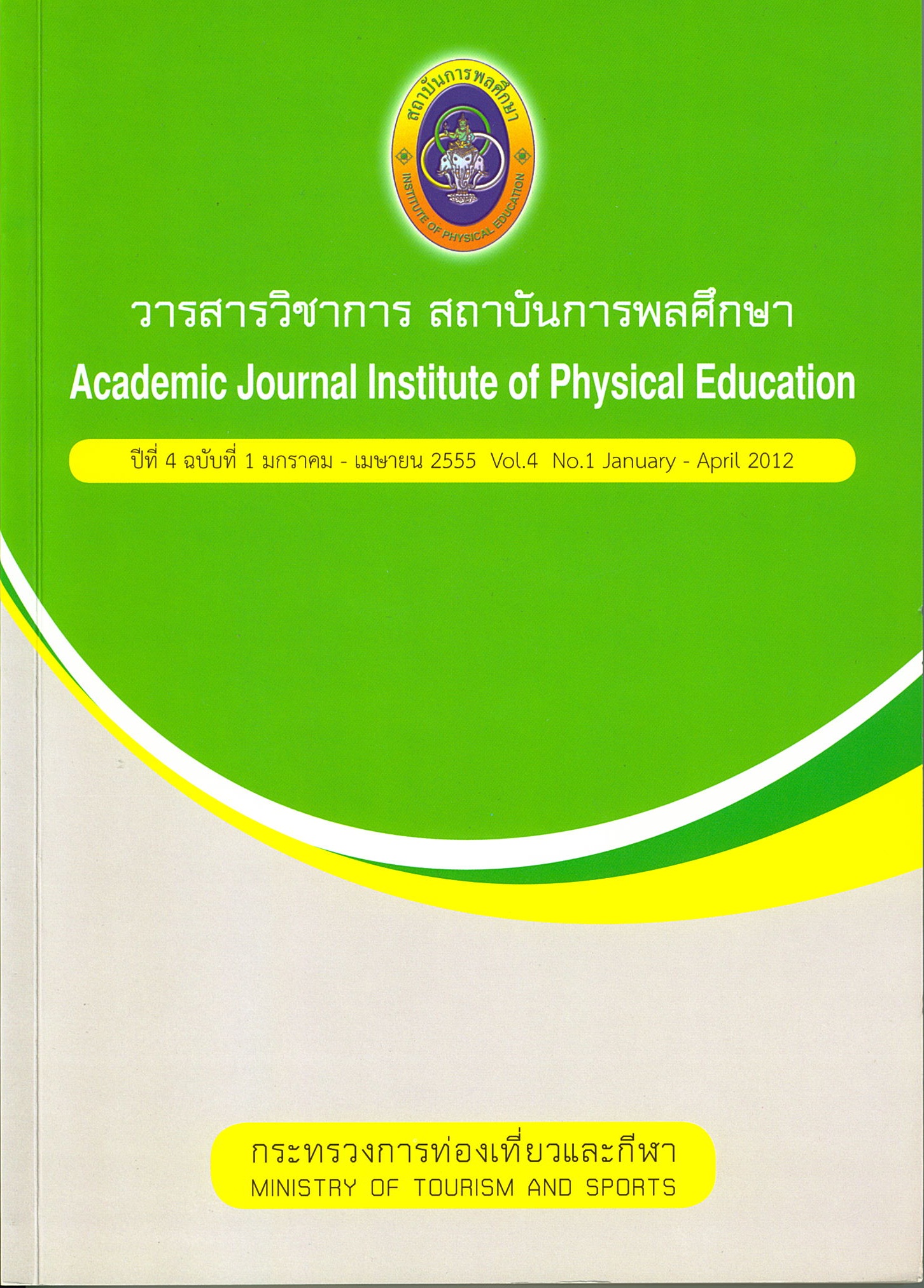CONTINUING EXERCISES PROCESS IN STUDENT EXCERTING EXERCISE AT INSTITUTE OF PHYSICAL EDUCATION LAMPANG
Main Article Content
Abstract
The purposes of this research were to study 1) The external factors about problems and obstacles to exercise such as personal, environmental, or social factors. 2) Factors which helped support (Exercise-contributing factors) 3) Process to encourage exercising of the students who came to exercise in the Institute of Physical Education. The Purposive Sampling Method was used to select 30 people (17 male and 13 female) who had continuously come to exercise for the past 5 years. Tools were used in 1 and 2 factors being a standard 5 level questionnaire. As for 3 factor used an individual in depthinterview pertaining to continuous exercise behavior pattern by experts and the detailed interview, close observation through personal participation, recording information from actual field exercising, and examining data triangulation were utilized. The results of research were as follows;
1) Problems and obstacles in External Factors
- Personal factors: As a whole, they were given a medium rated. In each section shown exercising after long day of study was rated as high. As for “lack of previous exercising experience” was rated rather low.
- Environmental factors: This problem was rated as medium. Lack of an area or place to keep personal exercising equipment/clothing. The factor which was given high rating
was the safe and ample parking space.
- Social factors: As a whole, they were at a low level. Lack of qualified experts to provide guidance and proper instructions in certain exercising field. Also, it lacked the support from family members or even friends. Both factors were rated as the lowest to
rather low respectively as for the lack of an initial first aid attendant, was given a medium rating score.
2) Factors which helped support was given a medium rating (X=3.27, S.D=0.91) Parents and guardians supported their children in the exercising was not far from their homes or domicile. The public relation had effective advertising to invite people to come and exercise, also advertised proper ways to exercise. All these activities were given a very high rating. The rating given for the lack of physical education instructors to give proper exercising advice was rated as low.
3) Process to encourage continuous exercising
- Action step. It was a psychological phenomena based on my own motivation, recognize mental concept that the exercise was good and beneficial.
- Maintenance step It was a self psychological factor based on self motivation, Physiology, environment and social. Understanding to maintain/achieve good health.
- Termination, adoption It was able to see their images which were derived from their own point of view. They realized the importance, necessity, benefit and value of exercising and thought of their friends and relatives as well as encouraged them to join in exercising.
Article Details
The published article is a copyright of the Academic Journal of Thailand National Sports University. The passage appeared in each article in this academic journal is a perspective of each author which is not related to the journal. Each author is required to be responsible for all components of his/her own article. If there are any mistakes, each author must be responsible for those mistakes on his/her own.
References
ธเนศ ต่วนชะเอม. (2549). แผนที่พัฒนาเศรษฐกิจและสังคมแห่งชาติฉบับที่ 10 พ.ศ. 2550 - 2554 และเทคนิคและวิธีการเขียนข้อเสนอการวิจัย เพื่อเสนอของบประมาณประจําปีงบประมาณ พ.ศ. 2551 ตามมติคณะรัฐมนตรี, กรุงเทพ ฯ กลุ่มวิจัยและพัฒนาคุณภาพการศึกษา กองส่งเสริม วิชาการ สถาบันการพลศึกษา กระทรวงการท่องเที่ยวและกีฬา : (เอกสารประกอบการประชุม สัมมนา เชิงปฏิบัติการ การวิจัยและพัฒนาคุณภาพการศึกษาของ สถาบันการพลศึกษา 27 พฤศจิกายน – 1 ธันวาคม 2549).
ประภาเพ็ญ สุวรรณ. (2526). ทัศนคติ : การวัดการเปลี่ยนแปลงและพฤติกรรมอนามัย. พิมพ์ครั้งที่ 2. กรุงเทพฯ : โอเดียนสโตร์.
พรรณิภา กาวิละ. (2548). กระบวนการนําไปสู่การคงไว้ซึ่งการ ออกกําลังกายอย่างต่อเนื่องของผู้มาใช้บริการออกกําลังกาย ภายในสถาบันการพลศึกษา วิทยาเขตลําปาง, วิทยานิพนธ์ ศึกษาศาสตรมหาบัณฑิต.
ศิวาภรณ์ อุบลชลเขตต์. (2532). การพัฒนาพฤติกรรมสุขภาพ. ม.ป.ท. : คณะแพทยศาสตร์ มหาวิทยาลัยสงขลานครินทร์.
Salonen, J.T. and Others. (1988, January). “Leisure time and occupational physical Activity : Risk of Death from is clinic heart disease” American Journal of Epidemiology. 127, 87-94

